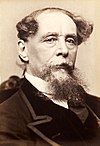
Charles John Huffam Dickens was an English novelist, journalist, short story writer and social critic. He created some of literature's best-known fictional characters, and is regarded by many as the greatest novelist of the Victorian era. His works enjoyed unprecedented popularity during his lifetime and, by the 20th century, critics and scholars had recognised him as a literary genius. His novels and short stories are widely read today.

Charles-François Gounod, usually known as Charles Gounod, was a French composer. He wrote twelve operas, of which the most popular has always been Faust (1859); his Roméo et Juliette (1867) also remains in the international repertory. He composed a large amount of church music, many songs, and popular short pieces including his "Ave Maria" and "Funeral March of a Marionette".

William Wilkie Collins was an English novelist and playwright known especially for The Woman in White (1859), a mystery novel and early sensation novel, and for The Moonstone (1868), which established many of the ground rules of the modern detective novel and is also perhaps the earliest clear example of the police procedural genre.
This article contains information about the literary events and publications of 1857.

Household Words was an English weekly magazine edited by Charles Dickens in the 1850s. It took its name from the line in Shakespeare's Henry V: "Familiar in his mouth as household words."

Augustus Leopold Egg RA was a British Victorian artist, and member of The Clique best known for his modern triptych Past and Present (1858), which depicts the breakup of a middle-class Victorian family.
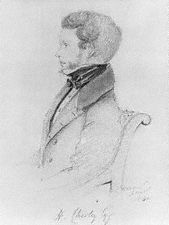
Henry Fothergill Chorley was an English literary, painting and music critic, writer and editor. He was also an author of novels, drama, poetry and lyrics.

Sir William Henry Weldon was a long-serving officer of arms at the College of Arms in London. Weldon is most unusual among the heralds of the College of Arms for having once been the owner of a circus. He was involved in a long-standing and very public civil suit with his wife.

The Frozen Deep is an 1856 play, originally staged as an amateur theatrical, written by Wilkie Collins under the substantial guidance of Charles Dickens. Dickens's hand was so prominent—beside acting in the play for several performances, he added a preface, altered lines, and attended to most of the props and sets—that the principal edition of the play is entitled "Under the Management of Charles Dickens". John C. Eckel wrote: "As usual with a play which passed into rehearsal under Dickens' auspices it came out improved. This was the case with The Frozen Deep. The changes were so numerous that the drama almost may be ascribed to Dickens". Dickens himself took the part of Richard Wardour and was stage-manager during its modest original staging in Dickens's home Tavistock House. The play, however, grew in influence through a series of outside performances, including one before Queen Victoria at the Royal Gallery of Illustration, and a three-performance run at the Manchester Free Trade Hall for the benefit of the Douglas Jerrold Fund to benefit the widow of Dickens's old friend, Douglas Jerrold. There, night after night, everyone—including, by some accounts, the carpenters and the stage-hands—was moved to tears by the play. It also brought Dickens together with Ellen Ternan, an actress he hired to play one of the parts, and for whom he would later leave his wife Catherine. The play remained unpublished until a private printing appeared sometime in 1866.
The bibliography of Charles Dickens (1812–1870) includes more than a dozen major novels, many short stories, several plays, several non-fiction books, and individual essays and articles. Dickens's novels were serialized initially in weekly or monthly magazines, then reprinted in standard book formats.
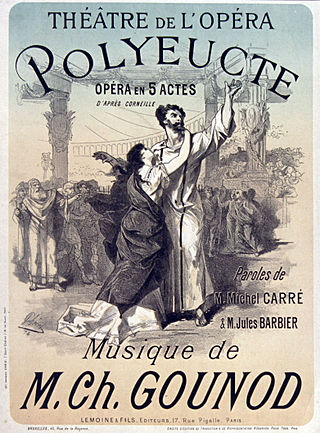
Polyeucte is an opera in five acts by Charles Gounod. The libretto was by Jules Barbier and Michel Carré, after the play of the same name (1643) by Pierre Corneille, about Saint Polyeuctus, an early Roman martyr in Armenia. Originally intended for the Salle Le Peletier in Paris, the premiere was delayed when that theatre was destroyed by fire in October 1873. The work eventually premiered in the new Palais Garnier on 7 October 1878.
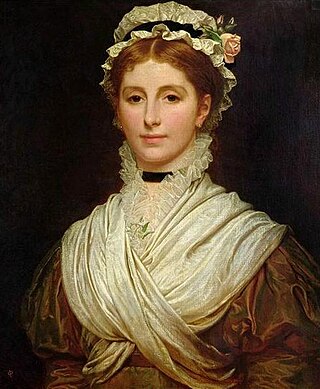
Catherine Elizabeth Macready Perugini was an English painter of the Victorian era and the daughter of Catherine Dickens and Charles Dickens.

Georgina Hogarth was the sister-in-law, housekeeper, and adviser of English novelist Charles Dickens and the editor of three volumes of his collected letters after his death.
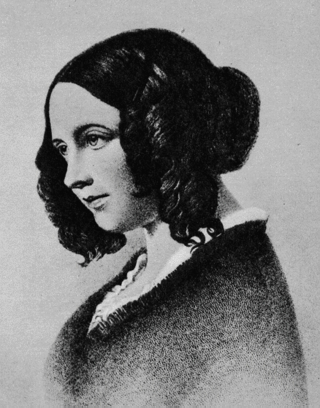
Catherine Thomson "Kate" Dickens was the wife of English novelist Charles Dickens, the mother of his ten children, and a writer of domestic management.
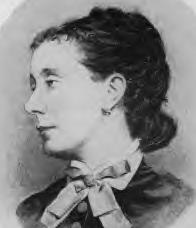
Mary "Mamie" Dickens was the eldest daughter of the English novelist Charles Dickens and his wife Catherine. She wrote a book of reminiscences about her father, and in conjunction with her aunt, Georgina Hogarth, she edited the first collection of his letters.

The Dickens family are the descendants of John Dickens, the father of the English novelist Charles Dickens. John Dickens was a clerk in the Royal Navy Pay Office and had eight children from his marriage to Elizabeth Barrow. Their second child and eldest son was Charles Dickens, whose descendants include the novelist Monica Dickens, the writer Lucinda Dickens Hawksley and the actors Harry Lloyd and Brian Forster.

"The Haunted House" is a set of short stories published in 1859 for the weekly periodical All the Year Round. It was "Conducted by Charles Dickens", with Charles Dickens writing the opening and closing stories, framing stories by Dickens himself and five other authors.

Georgina Weldon was a British litigant and amateur soprano of the Victorian era.

William Henry Wills JP was a British journalist, playwright, a newspaper editor and a close friend and confidant of the author Charles Dickens, who entrusted Wills with the task of forwarding his letters to his mistress Ellen Ternan.

The British Medical Association War Memorial, officially the War Memorial at British Medical Association House, Tavistock Square, Bloomsbury, London, commemorates men and women of the medical professions from the British Empire and Commonwealth who died in the Second World War. The memorial was commissioned by the British Medical Association and designed by the sculptor James Woodford. Unveiled in 1954 by Sir John McNee, then President of the BMA, and dedicated by Geoffrey Fisher, the Archbishop of Canterbury, it became a Grade II* listed structure in 1998.




















